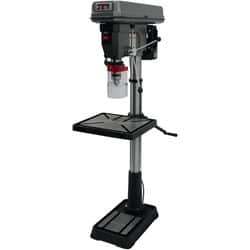Best Bench Drill Press — Buyers Guide, Top Pick, and Comparison
Should your trade or DIY jobs demand the pinnacle in perpendicular precision, but you lack the budget or space for a floor-standing unit — you need a bench drill press. Boasting a pillar-mounted vertical chuck, these versatile tools permit you to carefully raise and lower the drill bit to address your base material. Compatible with plastics, metals, and timbers — with the correct bit — you can utilize these units for basic 90-degree drilling or for honing, sanding, polishing, and screw tapping. Available as basic and affordable manual speed models through to premium-grade digital velocity machines — there’s a tool for every budget or experience level.
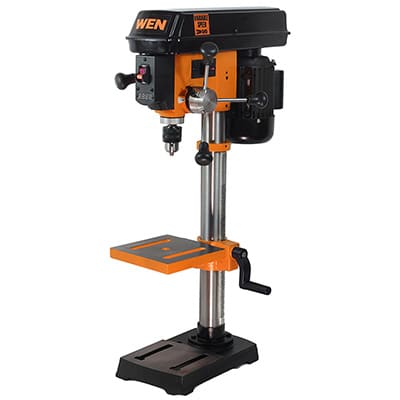
- Table size of 9.5 inches.
- Tilting table.
- Hefty cast-iron base.
- Extending work area.
- 0.625-inch keyed chuck.
Bench Drill Press Product Comparison Table
| IMAGE | PRODUCT | DETAILS | ||
|---|---|---|---|---|
|
Best for Variable Speed 
|
Best for Variable Speed
|
WEN 4214
|
Features
|
Check Price at Amazon WEN 4214 Review WEN 4214 Review |
|
Best for Power 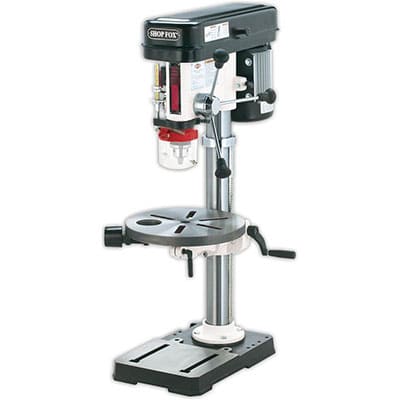
|
Best for Power
|
Shop Fox 1668
|
Features
|
Check Price at Amazon Shop Fox 1668 Review Shop Fox 1668 Review |
|
Best for Laser Guiding 
|
Best for Laser Guiding
|
WEN 4212
|
Features
|
Check Price at Amazon WEN 4212 Review WEN 4212 Review |
|
Best 0.5-Inch Chuck 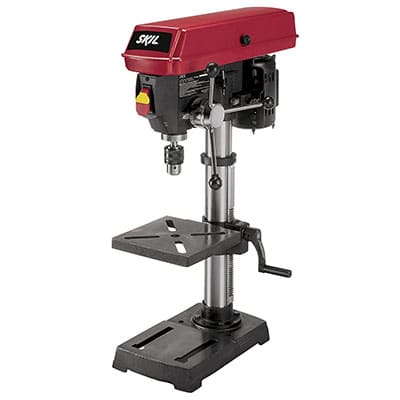
|
Best 0.5-Inch Chuck
|
SKIL 3320
|
Features
|
Check Price at Amazon SKIL 3320 Review SKIL 3320 Review |
|
Best Back to Basics 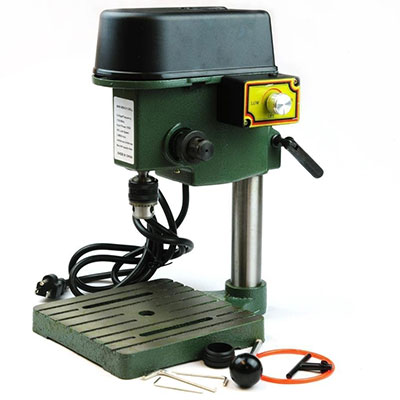
|
Best Back to Basics
|
Eurotools DRL-300
|
Features
|
Check Price at Amazon Eurotools DRL-300 Review Eurotools DRL-300 Review |
Best Bench Drill Press Buying Guide
Compact, powerful, and with a small footprint — the bench drill press is the consummate perpendicular drilling tool for engineers, woodworkers, machinists, and enthusiastic DIYers.
Taking up less space than their floor-standing counterparts, these workshop essentials allow for the ultimate in precision boring, while also offering sanding, polishing, honing, and thread-tapping capabilities.
While modestly sized for a pillar press, these versatile tools still knock out speeds in excess of 3000 rpm, are capable of addressing plastic, metal, and timber — and can include laser guiding and digital speed control.
When seeking the best bench drill press, consider the following:
- Distance of the swing.
- Size of the table.
- Speed range.
- Speed settings.
- Manual or digital control.
- Table tilt.
- Laser guiding.
- Footprint.
- Base weight.
What Is a Bench Top Drill Press?
For a detailed explanation of the entire drill press category, check out my in-depth guide to drill press units.
The bench drill press — sometimes referred to as a desktop drill press — is the most compact style in the pillar drill arena. Like their more substantial floor-standing cousins, they feature a boring head mounted upon a column.
Rotating side-positioned levers raise and lower the drill bit perpendicular to your base medium — allowing for the perfect 90-degree address. This permits you to bore into plastics, metals, and timber — while also enabling you to sand, polish, and tap threads.
As their names suggest, their compact build allows these units to sit on workbenches. Boasting a hefty metal foot for stability, you can typically bolt the machine to the bench for additional security.
Do You Need a Table Top Drill Press?
The initial question is — do you need a pillar drill, regardless of whether it’s a bench or floor model.
If you’re a casual DIYer who needs a tool for basic drilling and screwdriving — then the answer is no, you don’t need a drill press — opt for a drill/driver. Similarly, should your most common jobs involve addressing masonry or concrete — get yourself a hammer or rotary drill. Finally, if your projects necessitate confined-space or close-quarter work — go for a 90-degree drill instead.
But, should your work demand the pinnacle of precision tapping, drilling, polishing, and honing — then you need a drill press.
You can use these incredibly versatile tools for:
- Creating recesses for dowels.
- Boring perpendicularly into plastic, wood, and metal.
- Reaming.
- Thread tapping.
- Tool sharpening.
- Overhead routing.
- Forming mortises.
- Sanding.
- Polishing.
Bench Top Pillar Drill vs Floor Drill Press
For a detailed comparison of floor and drill press machines, check out my in-depth guide here.
However, as a brief outline, the advantages of the best table top drill press over their floor-standing equivalents are:
- Lighter on the wallet.
- Require less space.
- Typically more straightforward to operate.
- Can be an affordable introduction to pillar drilling.
- Easier to maintain.
- Can be relatively effortlessly relocated.
How to Choose the Best Bench Drill
While all pillar units share the same address characteristics of perpendicular drilling, they differ in crucial areas, that may or may not make them suitable for your trade or DIY projects.
Hence when reading online bench drill press reviews or performing your own research, think about the following factors:
Swing Distance
Definitely the primary consideration when choosing the best bench drill press for metal, wood, and plastic.
The swing is the horizontal distance between the chuck and the rear pillar — multiplied by two. This gives you the maximum dimensions of your base material you can place on the machine — to be able to drill a center hole.
For example, a 12’ benchtop drill press swing — as featured on the WEN 4214 — means you can bore into materials 12 inches wide, with the hole being placed six inches from the material edge. Hence, when choosing your machine, consider the size of your most commonly used mediums.
Typically, bench drill swing sizes range from 10 through to 13 inches. If your projects demand greater capacity, then you need to opt for a floor-standing heavy duty benchtop drill press.
Table Size
The table is the area upon which you place your base material in preparation for drilling. Generally, speaking, the larger the surface area — the more substantial sheets or timbers the unit can support, and the higher the stability.
Most benchtop pillar drills have a table around 8-10 inches, although some models — like the WEN 4214 — have an extending capability that can nearly double the table dimensions.
Speed Range
Stated in rpm, the speed specifications explain the rate at which the bit rotates.
When choosing your ideal benchtop drill press for metal, timber, or plastic — look for models with a significant speed range. That is from a modest, slow rotation through to rapid, intense revolutions.
At the bottom end, you need a restricted, rotary action for addressing dense mediums or thread tapping — otherwise, you’ll damage the bit and/or your target medium. High-velocity rotations permit you to plow through repetitive woodwork projects.
For the ultimate in versatility, I recommend looking for a unit that offers a 300 to 3000 rpm speed range — such as the Shop Fox 1668.
Number of Speed Settings
Worktop pillar machines, especially the budget and mini bench drill press models, typically feature preset speed settings. In most circumstances, you change the output rapidity by manually moving the drive belt onto a different pulley.
Ideally, the greater the number of predetermined rapidity modes — the higher the versatility and control in your hands. Hence, personally, I’d opt for a unit such as the Shop Fox 1668 that includes 12 settings.
However, for trade-pros and DIYers who demand nothing less than the ultimate in velocity control — you need a digital speed machine.
Digital Speed Control
The digital bench drill press — sometimes called an infinitely variable speed bench drill press — allows you to adjust the output rapidity via an LCD or LED display. Typically set by a button or dial, you can choose the speed in single rpm increments — meaning the ideal rotation to suit your base material.
This useful feature is typically the domain of industrial benchtop drill press units — with a concomitant price tag — as seen on the WEN 4212.
Tilt
Whether you opt for a substantial 12’ inch benchtop drill press, or a more modest 6.75-inch desktop drill press — such as the Eurotools DRL-300 — I suggest checking out whether the unit has a tilting table.
Machines with this capability — for example, the SKIL 3220 — allow you to drill away from the vertical plane, increasing the flexibility of your tool.
Laser Guiding
Read any reliable bench top drill press reviews, and you’ll discover that machines with laser guiding are considered to be the pinnacle of accuracy.
These units throw a laser dot or crosshair onto your target medium — indicating the exact point at which the bit will penetrate. This prevents you from having to perform test addresses with the bit before activating the machine and reduces the likelihood of inaccurate boring — which costs time and material. If this feature is of interest, check out the WEN 4214.
Size
While relatively compact compared to their floor-standing cousins, even a small bench drill press unit will take up considerable space on your worktop.
Hence, check out the footprint of your chosen machine before purchase to ensure you have sufficient surface area to place the power tool. Furthermore, remember that many materials, such as timber or metal sheeting, will overhang to one or more sides — meaning you need to check side clearance too.
Many table top drill press reviews declare the Eurotools DRL-300 to be one of the most compact machines on the market — although its back-to-basics design may make it undesirable for experienced users.
Base Construction
Hence, the size and weight of the base depend upon your personal preferences. Additionally, check out if the foot includes pre-molded bolt holes, enabling you to securely attach the unit to your bench.
Additional Features
- Lubricant.
- Interchangeable chucks.
- Assembly or tool wrench.
- Chuck key.
- Integrated work lamp.
- Securing vices.
- Long warranties.
- Vacuum dust port.
- Grinding, sanding, tapping, and polishing accessories.
- Telescoping bit guard.
Conclusion
When choosing your consummate machine, ensure that it has sufficient swing to cope with the size of your materials, and adequate speed ranges to deal with your project types.
Furthermore, look at whether the table tilts for angled drilling and if it expands to accommodate larger mediums. Finally, consider whether you’re content with a manually operated speed control, or would prefer the fine accuracy of a digital unit.
Sure, these tools aren’t for all DIYers and contractors. They can’t bore horizontally, making them useless for addressing walls, doors, and fences. Furthermore, some guys may prefer a more powerful floor-standing machine that’s more suited to substantial timber and metal sheets.
However, if you demand the ultimate in perpendicular drilling accuracy in a compact, workshop-friendly unit — then get your hands on a bench drill press.
Benchtop Drill Press FAQs
Q: What Is a Bench Top Drill Press?
A bench drill tool press features a vertical drill bit mounted on a pillar. Side-positioned levers allow you to raise and lower the bit for an accurate address of your base material. More compact than floor-standing units, they sit comfortably on workbenches.
Q: What Is the Best Bench Drilling Press?
In my eyes, the ultimate drill press for workbenches is the WEN 4214. It boasts laser guiding, digital speed control, and a cast-iron base.
Q: Can You Buy a 5 Speed Bench Drill Press?
Yes. The SKIL 3320 bench drill is a five-speed machine that includes a laser guidance system for elevated accuracy.
Q: What Should I Look for In a Bench Press Drill Machine?
When seeking the consummate bench pillar drill press, check out the speed range, swing distance, and the size of the table. Additionally, consider whether you would prefer manual or digital velocity control, and if you would find a laser guide beneficial.
Q: What Should I Look for In a Bench Press Drill Machine?
When seeking the consummate bench pillar drill press, check out the speed range, swing distance, and the size of the table. Additionally, consider whether you would prefer manual or digital velocity control, and if you would find a laser guide beneficial.

